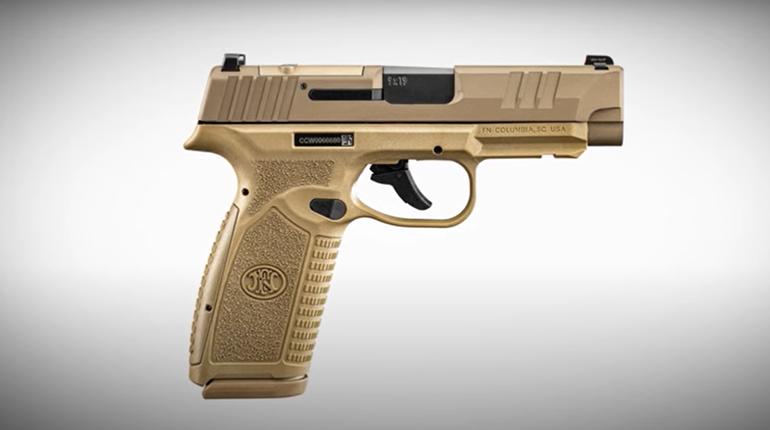Firearm: FN 509 Compact MRD FDE (MSRP: $799)
Not everyone is looking for a super-tiny, double-stack micro-9. Some folks are perfectly content with a mid-size pistol, preferring the larger grip, greater real estate for the support hand and slightly heavier weight for recoil control. Maybe they want a bigger red-dot sight than those that can fit on micro-pistols. For those people, FN-America’s 509 Compact MRD series might be just the thing.
Sizewise, the 509 Compact comes in somewhere between a gun the size of the Glock G19 and the Springfield Armory Hellcat. It’s 6.8 inches long overall with a 3.7-inch barrel, 4.8 inches high with the 12-round magazine installed and weighs 25.5 ounces. The 509 Compact falls into the sweet spot of being able to both conceal easily without being significantly harder to shoot. There’s even two different size backstraps to better fit the 509 Compact to your hand. It’s a great system that, unfortunately, sometimes gets overlooked.
The FN 509’s trigger is more like the Smith & Wesson M&P in that it uses a hinge system for safety. I’m a fan of this style of safety rather than the bladed-safety style, because it changes the tactile feel of the trigger itself. It’s a personal choice, definitely, but if you’re not of a fan of the bladed-trigger, here’s another option. The 509 Compact has ambidextrous controls, too, for those that are of the left-handed persuasion or just see the value of training with either hand.
The optics-mounting portion, MRD, is a truly ingenious system that uses a mixture of plates and inserts to mount 10 different optic footprints. Rather than rely on plastic plates that can break over time or metal inserts that require extra screws to tighten, the MRD system has a flush plate that sits on a rubber o-ring for tension that works either directly with an optic or in conjunction with a plastic insert that sits on top of the plate. It sounds far more complicated than it actually is – and FN includes a handy quick-reference guide with the MRD system. There are also six different types of mounting screws included, which is super handy.
Holster: Henry Holsters Flint AIWB/IWB (MSRP: $75)
I’ve become a big fan of the uncomplicated holsters from Henry Holsters. The company’s holsters are only available in right-hand orientation (sorry, lefties) and only come in black, so there’s not much to think about on that end. Where there is a lot of choice, though, is in the attachment methods – pull-the-dot loops, DCC monoblocks and griphook options are available. Tuckable attachment methods are available for those who want deeper concealment, and both TuckStrut and ModWing attachments are available to keep the Flint tucked into the body.
We’ve opted for pull-the-dot loops and a ModWing for appendix-position carry in this set up, as well as a sweatguard and optics cut. With warmer weather on the way, the sweatguard just makes sense (and helps prevent rust and other complications on the slide), and of course for the MRD version the optics cut is necessary. All this comes at a price that’s quite reasonable for a custom-built holster. Lastly, as I’ve noted before on other Henry Holsters, the company smartly stamps the firearm model for which it is designed on the body of the holster, making it super easy to identify.
Optic: Holosun HE509T-RD (MSRP: $505.87)
Most pistol-mounted red-dot sights are what are called open emitters – the LED that projects the dot onto the lens is open to the elements. More companies have started to develop closed-emitter pistol dots, most notably the Aimpoint Acro. Holosun offers its take on the closed emitter sight with the HE509T-RD, which uses a multi-reticle system that toggles between a 2-MOA single dot and a 2-MOA dot/32-MOA circle combination. Battery life is 50,000 hours on setting 6 (out of 12), and there’s a solar failsafe that powers the dot even when the battery is dead.
Closed-emitter red dots have the disadvantages of both being heavier than open-emitter versions and harder to mount, since you can’t directly bolt the unit to a slide cut. Advantages, though, are greater weather resistance, less glare and generally more robust construction – most carbine-mounted red-dot sights are of the closed-emitter variety. It’s definitely a tradeoff, especially since the extra size of the housing on the closed-emitter dot may require some adjustment in one’s carry position. However, the benefits are pretty substantial, too, so it’s worth investigation.

























